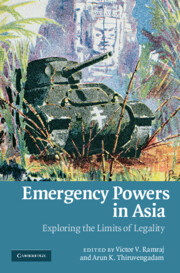Book contents
- Frontmatter
- Contents
- List of contributors
- Preface
- 1 Introduction: emergency powers and constitutionalism in Asia
- PART I Perspectives from legal and political theory
- PART II Postcolonial and post-conflict transitions
- PART III Emergencies, executive power and constitutional order
- PART IV The role of the courts
- 14 Constitutionalised emergency powers: a plague on Asian constitutionalism?
- 15 Political emergencies in the Philippines: changing labels and the unchanging need for legitimacy
- 16 Islamism as a response to emergency rule in Pakistan: the surprising proposal of Justice A. R. Cornelius
- 17 Asian judiciaries and emergency powers: reasons for optimism?
- Index
- References
14 - Constitutionalised emergency powers: a plague on Asian constitutionalism?
from PART IV - The role of the courts
Published online by Cambridge University Press: 04 August 2010
- Frontmatter
- Contents
- List of contributors
- Preface
- 1 Introduction: emergency powers and constitutionalism in Asia
- PART I Perspectives from legal and political theory
- PART II Postcolonial and post-conflict transitions
- PART III Emergencies, executive power and constitutional order
- PART IV The role of the courts
- 14 Constitutionalised emergency powers: a plague on Asian constitutionalism?
- 15 Political emergencies in the Philippines: changing labels and the unchanging need for legitimacy
- 16 Islamism as a response to emergency rule in Pakistan: the surprising proposal of Justice A. R. Cornelius
- 17 Asian judiciaries and emergency powers: reasons for optimism?
- Index
- References
Summary
Introduction
A conspicuous distinction between Asian constitutional frameworks and those of many constitutional liberal democracies – particularly those in the Anglo-American tradition, such as the United States, the United Kingdom, Canada, New Zealand and Australia – is the omission of a constitutionalised and elaborate framework of emergency powers from the national constitutions of these liberal-democratic countries. Does the existence of such a framework in many Asian constitutions uphold or undermine the rule of law? To what extent can the courts protect the rule of law in the face of a deployment of sweeping powers following a declaration or proclamation of emergency? Can specific constitutional norms be crystallised by the courts so that the constitutionality of emergency powers might continue to be tested in the courts? The theme running through this chapter is that in times of crisis (real or imaginary) the invocation of sweeping powers embodied in a constitution poses a more serious threat to constitutionalism than when such powers are in ordinary statutory form. The next part of the chapter (Part II) examines the experience of constitutionalised emergency powers in Asia, explaining how those powers operate and the problems arising from their use. The following part (Part III) defends the use of ordinary emergency powers in light of this experience.
The dilemmas of constitutionalised emergency powers
In many Asian countries, the framers of the constitution were motivated by the best of intentions when they advocated the embodiment of emergency powers as a set of constitutional powers.
- Type
- Chapter
- Information
- Emergency Powers in AsiaExploring the Limits of Legality, pp. 393 - 411Publisher: Cambridge University PressPrint publication year: 2009



